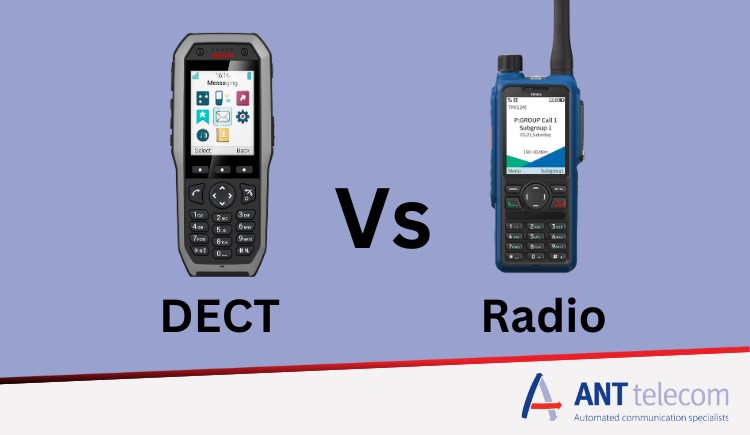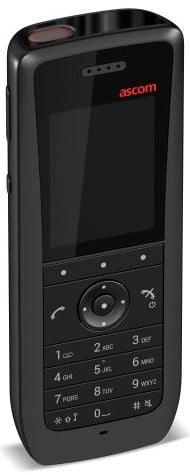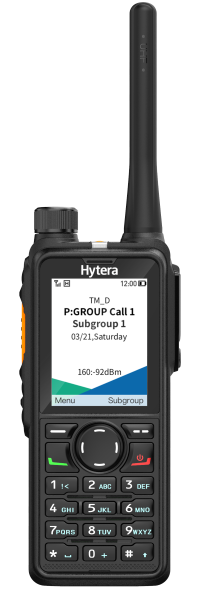
IP DECT and Digital Radio are both communication technologies that assist mobile workforces. They have similar functionality, for instances handsets can both support voice and messaging features, built in panic buttons and tilt sensors to protect lone workers.
Either platform can be networked so teams can communicate across multiple sites, both can integrate with other with 3rd party systems e.g. SCADA and BMS that can trigger site updates and alarms. You can open doors/gates directly from either a DECT phone or a Radio. And both offer ATEX handsets that can be used in intrinsically safe areas.
So if both platforms can do all of this, what can’t they each do or what differences do they have?
It’s a match-up between two communication technologies to see which is the superior – will it be IP DECT or will Digital Radio come out on top, only time will tell – let the battle commence!
IP Digital Enhanced Cordless Telecommunications (IP DECT)
IP DECT provides users with the freedom to make and receive 1:1 telephone calls anywhere on the site. It’s commonly used in many sectors like retail, manufacturing, care homes, healthcare etc. Handsets tend to be smaller and lighter than radio, and have features like phone book where users can store all their contacts’ and will show numbers the user has called, received and missed similarly to a mobile phone.
calls anywhere on the site. It’s commonly used in many sectors like retail, manufacturing, care homes, healthcare etc. Handsets tend to be smaller and lighter than radio, and have features like phone book where users can store all their contacts’ and will show numbers the user has called, received and missed similarly to a mobile phone.
Unlike radio, where communication tends to be kept to short messages and announcements with other radio users, DECT users can stay on a call for as long as they like as the platform can handle multiple, simultaneous calls without blocking the system. IP DECT can also integrate seamlessly to other voice networks i.e. UCaaS, Teams, which makes users far more contactable. This allows users to speak with other DECT users but also customers, suppliers and other employees.
DECT is generally a 1:1 communication platform but it can also be enhanced (similarly to radio) to allow one-to-many- calls where voice messages can be broadcasted to colleagues by pressing and holding down a button (PTT) on the DECT handset.
Digital Radio
Digital Radio helps users to communicate predominantly with other radio users on a 1-to-many basis. Unlike DECT, where you need to dial a number and wait till the call is answered before you can speak, with radio, you simple push a button and talk. Colleagues will hear the announcement and can respond in similar fashion.
a 1-to-many basis. Unlike DECT, where you need to dial a number and wait till the call is answered before you can speak, with radio, you simple push a button and talk. Colleagues will hear the announcement and can respond in similar fashion.
Radio can work back to back, i.e. just the handsets themselves and doesn’t need any infrastructure like repeaters to make them work (though it can be enhanced with this technology), which makes radio solutions very quick to deploy. Unlike DECT where multiple base stations are needed, with radio very large sites can often be covered with only one or two repeaters. These characteristics means that it is utilized by businesses across almost all industry sectors and is commonly deployed both on and off site. These include the ones mentioned above but also in Oil and Gas, Utilities, Mining, Water Treatment sites, Construction etc.
Radio manufacturers tend to produce a broader range of handsets and accessories offering more choice. ATEX radio ranges include Zone 0/20 as well Zone 1/21.
Though radio is generally a one-to many platform, it also possible to have 1:1 conversations over radio too. And though it isn’t a basic or standard set up, it is possible for radio users to make and receive external telephone calls too.
How about cost?
DECT and Radio handset costs are probably not too dissimilar in price when comparing low, middle and high end ranges. And even ATEX devices are more or less on par.
However, radio technology doesn’t require much additional infrastructure to make it work. Back to back radios can work fine on their own (albeit only together) and even large sites can be covered with a one or two repeaters.
DECT on the other hand needs base stations and the larger the site the more that are required. There are cabling costs too and ongoing support contracts tend to be higher with DECT because there is more hardware.
So in our experience DECT is generally more expensive when pricing like for like jobs – but users are also better connected too, so can get more value out of the solution as well.
Applications
There are some situations that radio makes more sense than DECT. In construction for instance Radio is always utilized as it is quick and easy to set up and deploy. Communication between workers is quite task oriented resulting in lots of short announcements, which works well over radio. Lengthy discussions conducted on site are done face to face and those that need to call suppliers or colleagues off site use 2G, 4G mobile phones. Once the construction is completed, radios can be easily deployed at the next job.
However, in industries where the workforce is highly mobile on site, IP DECT can help teams respond to events anywhere on site. In the pharmaceutical industry for instance departments like engineering, production, maintenance, operations, facilities and IT are often required to perform tasks throughout various areas of the site, yet must be contactable at all times.
Communication needs to 1:1 rather than in a group and employees are likely to need to speak with both internal as well as external parties. For example, engineering and maintenance teams will often need support from external suppliers to fix or service equipment. The ability to receive step by step instructions whilst working by a machine can be invaluable as it significantly increases 1st time fix rates, reduces downtime and increases overall equipment effectiveness.
Conclusion
So which platform comes out on top? That’s an easy one, as of course both solutions have a place in the market and it totally depends on each company’s set of requirements.
Sometimes having to weigh up both options can be challenging especially when users/departments have different requirements and preferences. But this is where an independent company like ANT Telecom, that offer both solutions can help. Over the years we have enhanced our Radio and DECT solutions (based on customer feedback) and can share valuable insight gained from delivering similar projects.
Based on your requirements, we can happily talk to you about the pros and cons of each platform to help you make the right choice of technology for the benefit of the whole company.
If you would like more information or a demonstration on our IP DECT or Digital Radio Solution, please get in touch. You can find all our contact details by clicking on the "contact us" button at the top right of this page.



